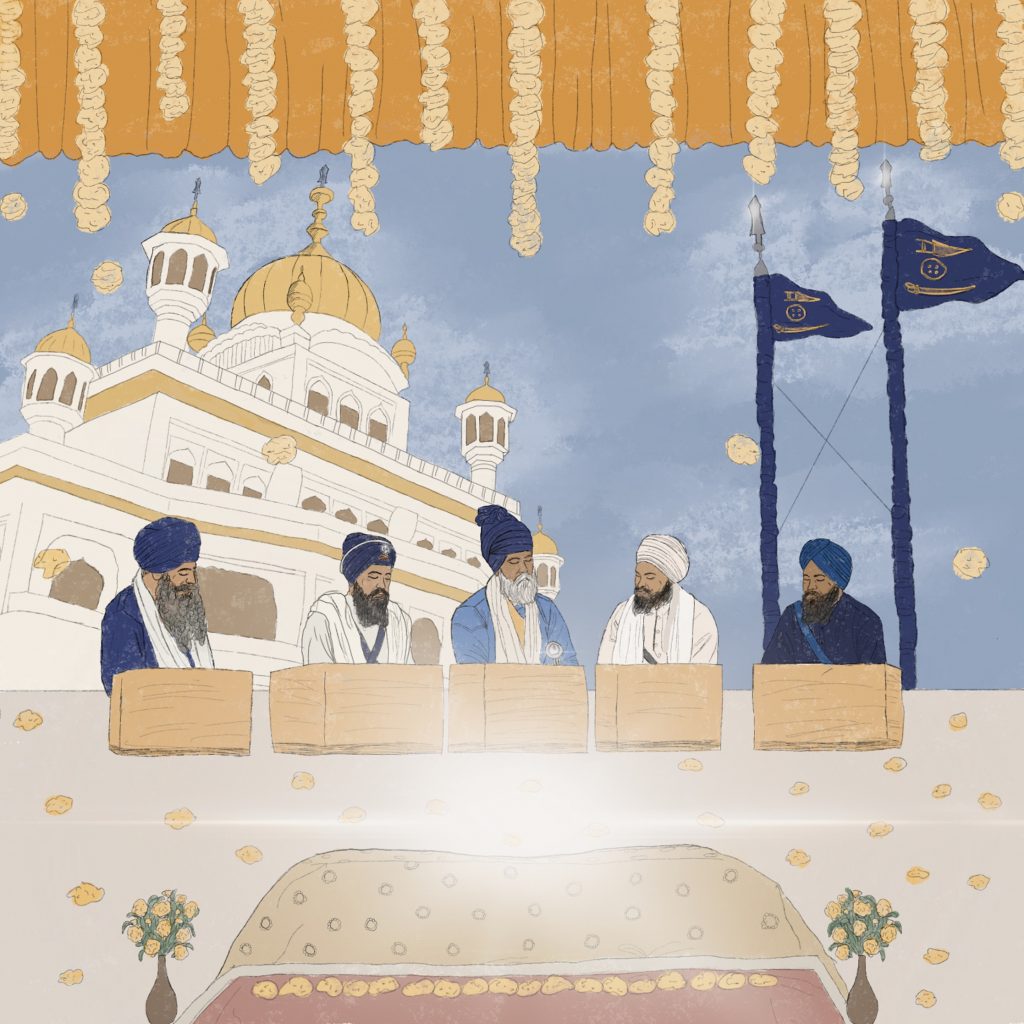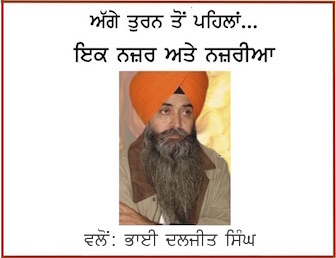Articles/Opinion » Over Seas » Sikh News
Freeing the Akaal Takht: Reflections on the Vishav Sikh Ekatarta
July 30, 2023 | By Shaheed Bibi Bimal Kaur Collective
On June 28th, hundreds of panth-dardi Gursikhs gathered in Maharaj’s hazoori at Sri Anandpur Sahib, reminiscent of darbars held by Dasme Patshah at the birthplace of the Khalsa Panth. The Ekatarta was the culmination of a year of organizing by panthic sevadaars to bring Sikh jathebandia, sampardava, and organizations together to discuss one central, permeating issue – the azaadi and governance of Sri Akaal Takht Sahib established by Sri Guru Hargobind Sahib Ji. The panj Sakhi Singhs humbly stood before the sangat and Sri Guru Granth Sahib Ji, in ardas, to ask Maharaj for aagia before they selected the Panj Piyare and held panthic vichaar.
In a moment dominated by reactionary discussions, primarily fueled by ego, division, and individualistic forms of leadership, the gurmatta provided a glimpse of genuine Sikh modes of governance, decision-making, and consensus-building. The opportunity to witness and participate in the ekatarta from the diaspora was unique because Gurmat and Maharaj were central to the process. The movement to free the Akal Takht and the gurmatta demarcates an essential step to revive the panth and build a collective, grassroots movement toward Sikh sovereignty and Khalistan. Its success reveals that panthic revival is not only possible but underway.

A view of Vishav Sikh Ikatarta held on 28 June 2023 at Anandpur Sahib | Image: Sikh Siyasat News
The Panth looks to Sri Akal Takht Sahi for leadership on Sikh issues, as it is the fortress for Khalsa’s sovereign governance that embodies miri-piri. Notably, the Akal Takht was attacked by the Indian army and military in June 1984, which can only be understood as a hamla on Sikh sovereignty and being that affects our consciousness to this day. Today, Sikh consciousness looks to the Akal Takht for leadership to move beyond seeking justice through electoral politics, government pleas, and failed leadership. The Gurmatta and Ekatarta reintroduces centuries of Sikh modes of governance in this conjuncture of electoral politics and state-nationhood politics.
Many Sikhs agree that our Akaal Takht is captured by worldly political powers and should be returned to its sovereign nature, as bestowed by Sache Patshah. Until our Akaal Takht is truly sovereign, we continue to live in gulaam conditions, our organizing efforts are restricted and confined to existing governance dichotomies and subjected to criminalization. Sikhs are caught within a bind, attempting to free the Akal Takht from various gulaam structures while simultaneously living and existing within those confining structures and psyche. In comparison to previous efforts to take Akal Takht Sahib’s control back, the recent Ekatarta attempts to unite the Panth (ekta), to implement Sikh modes of governance that center gurmat, and to build consensus and power among the sangat.

A representational artwork by Shaheed Bibi Bimal Kaur Collective
Imminent Sikh concerns related to beadbi, naujawan and nashe (drugs), and elimination of Punjabi maa-boli have largely been ignored by state leadership; Sikh resistance on these issues have been subjected to criminalization and often categorized as religious extremism. Past SGPC-selected jathedars have failed to stand with the Sangharsh and Panth on these issues because of their close alignment with the state’s politics and narrative against Khalistan. From the Kisaan Morcha (Farmer’s Protest) and movements to free Bandi Singhs to the recent counterinsurgency that targeted Sikh activists and journalists, it is clear that governmental pleas to the Indian government are constricting and limiting. A recent letter from Bandi Singhs at Assam Jail illustrates this as they appeal to the Indian government to improve the jail conditions. With a sovereign Akal Takht, Sikhs would have different coordinates to raise these concerns; therefore, the gurmatta’s focus on freeing the Akal Takht presents a collective, gurmat-approach to challenge the state instead of appealing to it.
This Gurmatta rejects the current gulaam conditions of the Akal Takht Sahib and its management by the SGPC. Instead, it constitutes a new jatha specifically for the seva sambhal of the Akal Takht that reasserts and protects the supreme and sovereign authority of the Akal Takht. By centering gurmatta-based decision making, this was a novel move to remove the influence of bippar da prabhav (electoral politics, political parties, individualistic forms of leadership) from the management of Akal Takht Sahib and reinstate the spirit of the Akaali who were nishkaam sevadaars of the Akal Takht in the past. Joint decision making, the Gurmatta, and joint leadership, Panch Pardhani, are two traditions through which Sikhs can make decisions collectively as a panth to build collective power and address panthic issues undisputedly.
By re-establishing the seva sambhal of the Akal Takht in the hands of nishkaam sevadaars and gursikhs, the Akal Takht can once again return to being the sovereign and unquestioned leader of the Sikh sangharsh for azaadi. Those less familiar with panthic politics and organizing often ask about the “practicality” of Khalistan, nation-statehood, and how to build a parallel governance structure. The gurmatta shows us that Sikhs do not have to search far to understand our mode of governance or borrow from the West; rather Akaal Purakh has bestowed us with Akaal Takht to assert our sovereignty and build collectively as sangat to center Maharaj.
The power lies with the aam (gursikh) sangat who gather together, reach a consensus, and immerse with more sangat, and build toward our Patshahi Dava. Building the fertile grounds for Sikhi to flourish is the more difficult challenge for Sikhs, especially as Sikhi and Sikhs are under attack at various scales. Focusing on the gurmatta and our own Sikh modes of governance, Sikh being, and patshahi shifts us away from sensationalized reactions to ongoing state-violence and challenges us to build a sustainable movement for Khalistan that moves beyond individual forms of leadership and will outlast our lives. As a disenfranchised, displaced panth, our psyches and minds have been conditioned to compromise gur-sidhant and rely on the same systems that created our conditions of gulaami in our pursuit to achieve our azaadi and Khalistan. Yet, to break free from this binary way of thinking, we must re-embrace the modes of governance and being established by Gursikhs in the past who followed and applied gur-sidhant to achieve Raj in their own times.
Khalistan Zindabad.
* Writers: Shaheed Bibi Bimal Kaur Collective.
⊕ RELATED ARTICLES:
⋅ Vishav Sikh Ikatarta: Reflections from a Sikh Naujawan in the Diaspora
To Get Sikh Siyasat News Alerts via WhatsApp:
(1) Save Our WhatsApp Number 0091-855-606-7689 to your phone contacts; and
(2) Send us Your Name via WhatsApp. Click Here to Send WhatsApp Message Now.
Sikh Siyasat is on Telegram Now. Subscribe to our Telegram Channel
Related Topics: Gurmatta, Revive Gurmatta, Shaheed Bibi Bimal Kaur Collective, Sikh Diaspora, Vishav Sikh Ikatarta




